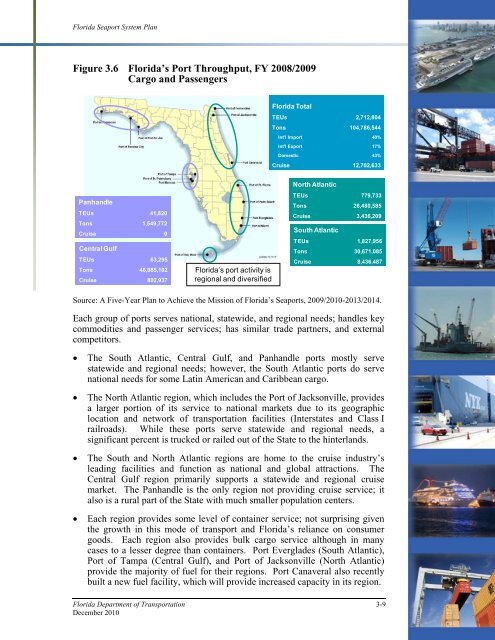Florida Seaport System Plan - SeaCIP
Florida Seaport System Plan - SeaCIP
Florida Seaport System Plan - SeaCIP
Create successful ePaper yourself
Turn your PDF publications into a flip-book with our unique Google optimized e-Paper software.
<strong>Florida</strong> <strong>Seaport</strong> <strong>System</strong> <strong>Plan</strong><br />
Figure 3.6 <strong>Florida</strong>’s Port Throughput, FY 2008/2009<br />
Cargo and Passengers<br />
<strong>Florida</strong> Total<br />
TEUs 2,712,804<br />
Tons 104,786,544<br />
Int'l Import 40%<br />
Int'l Export 17%<br />
Domestic 43%<br />
Cruise 12,702,633<br />
Panhandle<br />
TEUs 41,820<br />
Tons 1,549,772<br />
Cruise 0<br />
Central Gulf<br />
TEUs 63,295<br />
Tons 46,085,102<br />
Cruise 802,937<br />
<strong>Florida</strong>’s port activity is<br />
regional and diversified<br />
North Atlantic<br />
TEUs 779,733<br />
Tons 26,480,585<br />
Cruise 3,436,209<br />
South Atlantic<br />
TEUs 1,827,956<br />
Tons 30,671,085<br />
Cruise 8,436,487<br />
Source: A Five-Year <strong>Plan</strong> to Achieve the Mission of <strong>Florida</strong>’s <strong>Seaport</strong>s, 2009/2010-2013/2014.<br />
Each group of ports serves national, statewide, and regional needs; handles key<br />
commodities and passenger services; has similar trade partners, and external<br />
competitors.<br />
• The South Atlantic, Central Gulf, and Panhandle ports mostly serve<br />
statewide and regional needs; however, the South Atlantic ports do serve<br />
national needs for some Latin American and Caribbean cargo.<br />
• The North Atlantic region, which includes the Port of Jacksonville, provides<br />
a larger portion of its service to national markets due to its geographic<br />
location and network of transportation facilities (Interstates and Class I<br />
railroads). While these ports serve statewide and regional needs, a<br />
significant percent is trucked or railed out of the State to the hinterlands.<br />
• The South and North Atlantic regions are home to the cruise industry’s<br />
leading facilities and function as national and global attractions. The<br />
Central Gulf region primarily supports a statewide and regional cruise<br />
market. The Panhandle is the only region not providing cruise service; it<br />
also is a rural part of the State with much smaller population centers.<br />
• Each region provides some level of container service; not surprising given<br />
the growth in this mode of transport and <strong>Florida</strong>’s reliance on consumer<br />
goods. Each region also provides bulk cargo service although in many<br />
cases to a lesser degree than containers. Port Everglades (South Atlantic),<br />
Port of Tampa (Central Gulf), and Port of Jacksonville (North Atlantic)<br />
provide the majority of fuel for their regions. Port Canaveral also recently<br />
built a new fuel facility, which will provide increased capacity in its region.<br />
<strong>Florida</strong> Department of Transportation 3-9<br />
December 2010
















